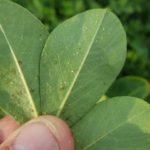Whiteflies can cause economic damage to plants in several ways. Heavy infestations of adults and their progeny can cause reduction in vigor and yield of older plants, due to sap removal. When adult and immature whiteflies feed, they also excrete honeydew, a sticky waste that is composed of plant sugars. Sooty mold will grow on honeydew-covered substrates, obscuring the leaf and reducing photosynthesis. This combination of weakened plants and subsequent fungus usually leads to reduced yield and quality.
Dr. Phillip Roberts UGA Extension Entomologist recently provided simple instructions for scouting whiteflies in cotton.
- Sample the 5th expanded leaf below the terminal.
- Treat when 50 percent of sampled leaves. are infested with multiple immatures – 5 or more per leaf.
- Insect Growth Regulators (Knack and Courier) are the backbone of SLWF management programs in cotton. Effects on SLWF populations are generally slow due to the life stages targeted by IGRs, however these products have long residual activity and perform very well when applied on a timely basis.
The attached document shows what to expect following an IGR application. SEE DOCUMENT HERE
I have been scouting peanuts locally, and am disturbed by the combination of spotty dry conditions, building populations of whitefly immatures, and declining plant conditions. Given the guidance of Extension Entomologists to make timely control methods, it is of course critical to make timely decisions in evaluating pest and crop conditions. Without additional guidance, I am using the following conditions to evaluate crop conditions.
- How long until harvest. Many of these peanuts need 60 days to harvest.
- What is the plant condition. Are the top of leaves are becoming pale, turning yellow and wilting.
- Presence of immatures. In years past we would have heavy adult whitefly pressure but few immatures on the bottom of leaves. I am seeing heavy immature feeding pressure, dozens per leaflet.
- What is the field condition, irrigated or rain-fed. I am not seeing declining plant conditions in irrigated fields, peanuts are status quo under good irrigation. Also some fields are receiving timely rainfall and not showing any stress. This may prove to be inappropriate criteria, but my concerns right now are dryland fields receiving inadequate rainfall. Some of these fields we have been getting rainfall measured in hundredths of an inch all through July, but I haven’t seen the “moisture meet the moisture” in these fields since June. There continues to be pockets of dry conditions during July in Gilchrist, Suwannee, Lafayette, Columbia, and Hamilton counties that I am aware of.
We will continue to look to Extension Entomologists in Florida, Georgia, and Alabama for guidance and to development recommendations. If you are seeing similar issues or have thoughts from your area, please let me know.



